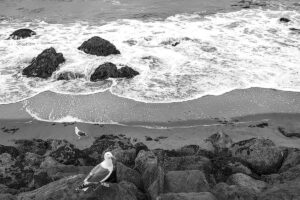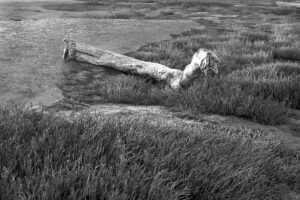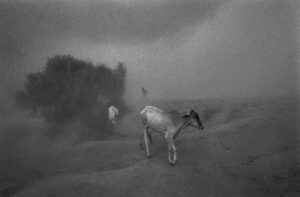“Echoes of Silence” An Exhibition of Photographs By Eminent Photographer Dev Inder

Dev Inder tries to comprehend the world of relationships through is photography work. Therefore, the three dimensional space he steps into becomes a suggestion and a cue for him creating “a relationship between two figures that had not existed before” John Szarkowski in The Photographer’s Eye. Endowed with an acute sense of seeing everything in the landscape comes forward to help unlock the doors of perception. Things like fallen branches, everydayness of a billboard, reeds bending light’ly to the breeze, earth as seed of grass, clouds emanations of the trees, autumnal ciphers of grass are the anagrams he tries to read through portal of 35 mm. This diversity enhances his range of expression with images happening at the focal plane of his artistic consciousness.
Nothing dies.
The ephemeral and the eternal coexisting as juxtaposed poles guide the compassionate lense of Dev Inder. Whatever he touches comes alive. “Landscape are culture before they are nature; constructs of the imagination projected onto wood, and water and rock.” Simon Schama (Landscape and Memory). And so, imbued with presences; actual or of the imagination Dev Inder’s pictures are the sites where he goes looking for resolution.
The photographer till the moment of shutter release is a condensed presence, all faculties summoned just to see. The very next moment everything evaporates; the scene, the self, the eye. The photographer folds his tripod and walks back. Behind his back the scene disintegrates into a lot of rock, trees, water and light. What of the nature shall we capture in a moment so profound? Dev Inder recounts visiting the same place to have a better shot but concludes “It’s not worth it. The moment was only then.”
Aware of the paradox, Dev Inder invites life into the landscape with all its presences, real or metaphoric, arranging them in a rhythmic correspondence. The sky and the clouds in the pictures lend weight to the frames, at once embracing and inhabiting the scene. The elements have terra-firma to stand on and solid space to grow into. Restrained tonal range subsumes hierarchies in participatory fervour.
He is also a minimalist in the sense in which he transforms landscapes into relationships with minimum appurtenance. In one of the photograph through deft composition he has tried to bind the entire valley in visual embrace with warped arms as tendrils curling around the visibilities in the frame. It is a photograph about union, the tree supplanting Dev Inder to enter into an embrace. Dwelling on the same strand let’s look at the picture of the More’ plains from Ladakh. By now most of us are familiar with the sweeping vistas of More’ plains and to most of us a wide angle shot of its immense physicality is enough to fill the frame of our imagination. But Dev Inder’s picture shows a vehicle emerging out of the far end of the convergence. Far from being a sedate perspective shot it seems to suggest life emerging out of land’s end, throbbing with presence.
The contemplative spirit of his work is also visible in another photograph; a small plant with broad leaves cradled by a rock with a shoot circling over to the top of the rock. There’s a risk of it being viewed as a binary of the animate and inanimate. But rounded edges of the rock and the encircling branch, the third element in the picture, make it into a picture of ecology. Rock is not passive. Giving off itself, rounding off angularities it supports and germinates life. He rock is not a theatre where life is enacted. It is part of life itself. The picture stops us to ponder.
Dev Inder also converses through spatial ambiguity and abstraction. Pliant space gets modulated into anagrams of intrigue and discovery. Abstraction is a reality whose meaning is yet to arrive. But this doesn’t make all randomness abstract. Unless the artist stands at the cusp of intelligibility of the patterns he/she ciphers the end product would be still-born. Aware of this, his semantic lexicon employs symbols with cultural affinity, for example concentric rings at the heart of a rock evoke the memory of a tree, towering rocks come alive with human forms in another picture. By reflecting near in the far Dev Inder is able to locate rhythm in seemingly vast randomness of the landscape. At times acute compression of the perspective melds the landscape into architecture. Afterall “it is our shaping perception that makes the difference between raw material and landscape” (Simon Schama; Landscape and Memory).



On rare occasion when he uses negative space he does so with finesse and purpose. In the picture where a man rests under the shadow of a rock which rests upon rather tenuously on a bigger rock. The chunk of negative space on the left if not attended to properly would make the composition precarious. However an aware photographer waits for the arrival of human form to step into that space, solidly anchoring the rock. Visually addressing the precarity of the rock tremendously enhances the restfulness of the scene.
In creating a consciousness of relationships, intimacy and intrigue Dev Inder invites the landscape to partner him. Dead stumps rise up in vertical verse. Lifeless branches of trees lying on the ground, breathless and bleached, become animated limbs by delicate handling of the form and tones. Landscapes of grit start teaming with life and redemption. As Walter Pater has famously said “All art constantly aspires towards condition of music”, we hear notes of music rise in Dev Inder’s “The Echoes of Silence”
12th to 18th November 2025
VENUE:
Jehangir Art Gallery
Terrace Gallery
161-B, M.G. Road
Kala Ghoda, Mumbai 400001